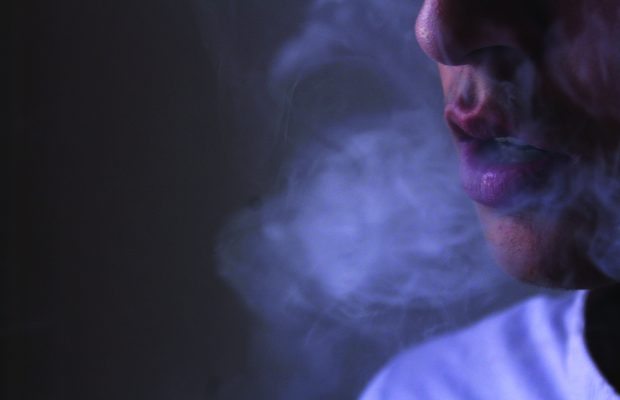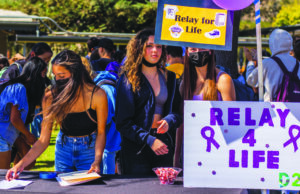Vaping: seeing through the fog

Juuls, suorins and e-cigarettes: These vaporization devices, or “vapes” are making daily appearances in the lunchroom, quad and bathrooms alike. Although these devices were originally created as a safer alternative to smoking, vapes are becoming more common among high school students for recreational use.
Vapes contain a concoction of vegetable glycerin, propylene glycol, nicotine and flavoring. The e-liquid is vaporized immediately before inhalation by heated conductive nickel or titanium coils inside the vape. This technology is used to consume several different kinds of psychoactive substances, with tetrahydrocannabinol (THC) and nicotine being the most common. The latter, however, has been soaring in popularity amongst high school students in the Conejo Valley area.
“I know adults who have vapes to stop cigarette smoking, and that’s what the actual use of those this is. But now, it’s just turned into something people are addicted to. Young people, too. It’s really widespread,” Frank*, senior said.
Ronald*, who owns a local vape store, seconds Frank’s point. He believes many companies that manufacture the devices originally had well-placed intentions to help adults quit smoking. However, an unintended consequence has been the younger generation’s fascination with the ostensibly “trendy” devices. “The problem is, to sell something it has to be cool, and unfortunately kids want cool things,” Ronald said.
While the tar and toxins filling cigarettes have since been removed in vapes, nicotine is still a major ingredient. As a result, its addictive properties are still a major problem for the students that use them.
When propylene glycol and vegetable glycerin are vaporized, the particles can cause respiratory distress. Heating propylene glycol can produce small amounts of formaldehyde, a chemical with a proven link to asthma and cancer. The Center for Environmental Health found the compound in more than half the vapes they tested, but even more concerning is the high concentration of nicotine found in their liquids.
The short-term effects of nicotine vary from the long-term effects. After inhaling nicotine, the user’s brain will trigger neurotransmitters such as serotonin and dopamine, both of which are associated with pleasure. The deeper the inhalation, the more relaxed the user will feel. Users generally call this feeling a “head rush.”
“You can ghost it, which is when you inhale (the vapor) and continue to inhale it, and it gives you a dome which is a term for when you get a head rush,” Frank said.
For Frank, a head rush feels similar to going on a roller coaster: “It feels like when you go up and up, and then dip straight down.”
Andrew*, freshman, started vaping this year with his friends. While vaping at a park, a local market or a friend’s house, Andrew got a first-hand account of the side effects. After inhaling off a juul or suorin, his friends “fall over or just start going crazy– they just start running laps or doing backflips.”
These effects do not concern him. “It’s kind of funny. We don’t really think about it, we just do it,” Andrew said.
In the long-term, nicotine has been proven to inflame, weaken and ultimately damage lung tissue. The amount of nicotine in a vapor device is also up to seven times more than that of a traditional cigarette. According to the American Association of Poison Control Centers, from Jan. 1, 2017 to Sept. 30, 2017, there have been 1,797 incidents of nicotine exposure.
“I know a person who would vape constantly. He had a reaction to it. Once he stopped, he was sick. His body would be shaking with a cold, cold sweat,” Frank said.
Why people vape:
Besides the addictive properties of nicotine, there are other reasons behind the growing popularity of vape usage. Many students feel that they have to vape to fit in.
“I think (my usage) might have started because of peer pressure because I didn’t really do that kind of stuff before,” Frank said. “When I started going to this school, I guess a bunch of my friends did it so I just did it. No real good reason, I guess. It’s not a good thing.”
Andrew shares a similar experience. “My friends were vaping and they were like ‘Hey, you should try it,’ so it was like peer pressure, I guess,” Andrew said.
Other students have joined in on the trend for amusement. “It’s just fun. You can do tricks with it. You can do french inhales– where you let the vapor come out through your nose– or Os– blowing vapor in an O shape. It’s just a way to pass time,” Will said.
Jane*, senior, agrees with Will. “I think the suorin is just fun, I don’t know,” she said.
“Regardless of what I’m selling, so long as it’s perceived as cool or trendy, a kid is going to want to get his hands on it. A lot times they say ‘We’re not gonna buy anything, we’re just looking.’” Ronald said, explaining the younger audience’s fascination with vaping. “At that point you’re just dealing with a bunch of people looking for what’s cool. Unfortunately, that goes on to the younger generation– that’s just how it works.”
Accessibility:
In 2016, California Governor Jerry Brown signed a bill to increase the legal age to buy tobacco related products from 18 to 21.
Ronald, whose store has a strict policy against selling vapes to minors, finds that many high schoolers, especially freshmen, enter his store at the beginning of the school year to purchase vapes. “The youngest (kid) that came in was 10 years old, and I told him I would call the cops if he doesn’t show me an ID,” Ronald said.
To prevent minors from purchasing vape-related products, Ronald makes sure to be cautious. “Anything e-liquid related, or vape-related this close to a high school, I pretty much card anyone who looks under 30. There’s not really any legal repercussions that I can take, but if it becomes a recurring issue, I will call the police,” Ronald said.
However, Ronald’s store’s aversion to selling minors is not shared by all vape shops in the area. Ronald himself is aware of a few stores nearby that sell to students.
Frank affirmed there are three vape shops in Newbury Park, one of which will sell to minors. “Some stores ask for ID. But I know a place that’s reliable that doesn’t ask for ID. Of course, unreliable for the state, reliable for the fiends.”
Frank finds the easy accessibility to vapes, especially for younger students, unsettling. “The guy that I know, he’s just looking to make a profit, like he’ll sell it to whoever,” Frank said. “I’ve seen someone who bought some (suorins) for freshmen the other day. Freshmen will come up and ask if you can get them one.”
Andrew confirms that he, along with fellow freshmen, get their vapes this way. “People buy (our juuls or suorins) from local vape stores or tobacco stores and then give it to us.”
Administration’s response:
The growing prevalence of vaping has led to a more contentious discussion concerning vape laws and rules both on and off of campus. The administration has a zero-tolerance policy on the subject.
“We are a (vape)-free environment by the state of California, and so there is zero tolerance for any of it,” Kelly Welch, assistant principal of attendance, said.
Welch explains that vaping is a violation of the California Education Code 48901 and the penalty, which is district-determined, is suspension. The length of an individual student’s suspension is determined by the amount of substance they were carrying and the overall severity of their offense.
Despite these restrictions, students still bring their vapes to school. “People will be vaping in class, or you can go into the bathroom they’ll be doing. Sometimes they’re out and about, walking around school, and they’ll be vaping,” Andrew said.
Sarah*, junior, recently had an incident with peers who were vaping in class. The student next to Sarah was vaping, so she requested to change seats. “I couldn’t focus because (the vapor) was right in my face,” Sarah said. “Here’s how I see it: I don’t care what you do outside of school, just don’t do it in class– it’s inconsiderate.”
According to Sarah, her attempts to change her seat were exaggerated among students on campus. “It turned into a big mess and a lot of misunderstanding. Everyone thinks that I ratted someone out,” Sarah said. “It really should be kept more private.”
Students like Sarah, Frank and Will*, senior, have all heard several claims regarding new district policies for vaping. All three of them had heard of a rumored policy where students are paid a $50 reward for reporting vapers.
Steve Lepire, principal, rejects these claims as completely baseless. “(The rumors are) totally unfounded. 100 percent untrue. The police are not giving a reward, nobody is giving an award. It’s just not true,” Lepire said.
According to Lepire, the school receives the majority of their information about vaping on campus through teachers reporting incidents or students’ Snapchat stories, where many students post pictures or videos of themselves vaping.
“People have a choice to do what they want when they’re at home, but when it’s on campus, it’s pretty clearly spelled out to them what they can or cannot have,” Lepire said.
Lepire encourages students to come and get help from administration. “If (students) came to us and said, ‘I have a problem, I need help with it,’ that’s what we’re here for,” Lepire said. “We have resources we can refer them to that are free.”
If you or someone you know have a vaping or smoking addiction, call 1-877-448-7848, the National Cancer Institute’s addiction hotline.
*names have been changed to protect anonymity



